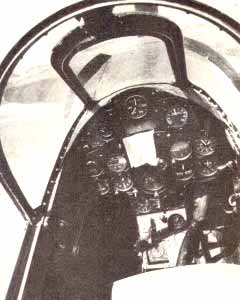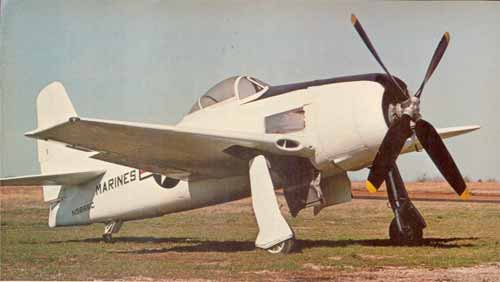It has been several weeks since I pushed the throttle
home on that big Pratt & Whitney R-2800, and I've flown a lot of
airplanes since, but I can't get that Bearcat out of my mind. I'll
be in the middle of an exciting conversation, and suddenly
my mind will shift gears, the lights go dim, and that tiny windscreen
pops up in front of me. I'm once again strapped in that miniscule Plexiglas
bubble, surrounded by a maximum of noise and a minimum of airplane.
As I blink my eyes, unbelievingly, my right hand unconsciously
twitches and the Texas horizon rotates in an effortless slow roll.
(Ed Note from 2008: now, 30-some years later,
the airplane still has the same effect on me.)
 |
The cockpit is not only form-fitting
but they put the controls, like gear, etc., right where you can
easily find them. |
Pilots may fly a Bearcat and not like it, and others may be indifferent,
but none of them will ever forget it. There are airplanes that do better
aerobatics, and others that get off shorter, and certainly some are
more comfortable, but there is only one airplane that mixes all these
ingredients together using raw horsepower as glue—that's Grumman's
fantastic Bearcat.
When Grumman builds a fighter, they don't mess around. The Bearcat
was the last of a 20-year string of successful prop-driven Navy fighters,
and they stuffed every little trick they knew into it. The design philosophy
for the Bearcat was simple: Get all the power you can into
the smallest airframe possible and still design it so it's a cinch
to land on a carrier.
I'm sure the Grumman engineers were a little disappointed when they
didn't get to see how their aluminum assassin stacked up against the
competition. By the time the F8F was all packaged and ready for operational
use, the War was over and the scream of turbojets began drowning out
that lovely sound of P&Ws. Only 1,266 Bearcats were built and most
of them were given to the French and Thai air forces. Supposedly, only
63 were released to the surplus market, which accounts for the small
number—around 16—that still exist in the United States.
Because of the airplane's short tour of duty, there are few ex-military
pilots who got to play with them at the taxpayers' expense, and there
are even fewer taxpayers who have gotten to shove that throttle to
the stop. About the only way you can fly a Bearcat, short of buying
one, is to go through Junior Burchinal's warbird school in Paris, Texas.
His Bearcat is the one with which Mira Slovak won the 1964 Reno Air
Race. Junior uses it for airshow work as well as for giving the ultimate
thrill to those who dare to hop aboard.
When I first saw her, she was next to her racing opposition,
the Mustang. There they were—one sleek, long and streamlined;
the other looking like a bullfrog trying to stand on tiptoes. They
were both intended to do basically the same thing, but their designers
took different approaches. North American decided to go for the cleanest
airframe possible so they could get maximum performance with a medium-size
engine. The Grumman gremlins decided they'd take the healthiest engine
available, strap a pilot to the accessory section and then
try to economize on aluminum.
The big prop presented an interesting problem for the Bearcat designers.
Where would they mount the gear? If it were long enough to keep the
prop out of the asphalt, it would have to be mounted just inboard of
the navigation lights to keep the wheels from touching each other when
retracted. They came up with a clever solution in articulated, two-piece
gear legs. The legs fold in two places, one at the normal position
at the wing, and the other more than a foot down the leg. This way,
when the gear is retracted, the upper portion goes out and the bottom
comes in.
After climbing up the spring-loaded steps chiseled into the fuselage,
you open the canopy by reaching inside a little trap door in the fuselage
and using the cockpit hand crank. Once inside, you know you've strapped
on a real performer. The first indication of its get-up-and-go is the
little window on the airspeed indicator that says, "Mach." Mach?
That all-important gauge is at the top of the panel where you can't
possibly miss it.
This is probably one of the smallest fighter cockpits around, at least
compared with the few American fighters I've sat in. A big man would
have to be a hunchback to clear the canopy. It isn't necessarily cramped,
but it definitely has that tailored-to-fit feel. Also, it's one of
the best finished cockpits the U.S. ever put behind a propeller. A
lot of the WW-II birds, especially Navy types, look as if they were
designed by the same guy who plans the plumbing in sub-way tunnels,
because tubes and wires and fittings usually stick out all over the
place. After all, they weren't supposed to look pretty. The Bearcat,
on the other hand, has none of the Spartan, stark look. The wires are
enclosed in consoles on both sides of the cockpit that bend up gracefully
to meet the panel.
GO TO NEXT PAGE
|

